When we think about dangerous extinct animals, it’s usually the T-Rex that springs to mind. No doubt about it, the T-Rex was a dangerous and formidable predator, but there were many larger, much faster, and more deadly animals than the ‘king of the tyrant lizards.’ Here are 9 dangerous extinct animals. Thank your lucky stars, you’ll never have to meet them!
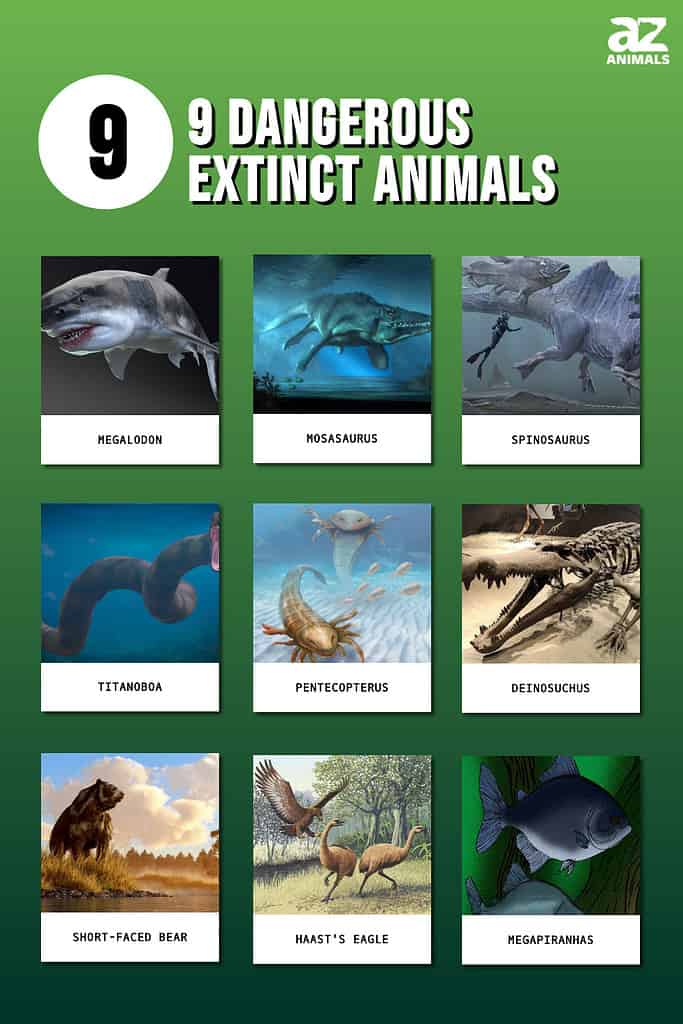
Megalodon

Megalodons were 60 feet long and ate great white sharks
©racksuz/Shutterstock.com
Dubbed the most giant shark to have ever lived, the megalodon was a massive shark that roamed the Tethys sea, which are the modern-day Pacific and Atlantic oceans.
This extinct mega-shark was an apex predator. It was around 60 feet long, and experts estimate it weighed up to 227,500 pounds. That’s 20-50 times the size of today’s great white sharks and around the size of a bowling alley!
Megalodon ate great white sharks, turtles, and their teeth marks are found in fossilized ammonite remains. With banana-sized teeth, surely megalodon tops the most dangerous extinct animal charts.
Megalodon became extinct 2.6 million years ago in the Pliocene era, but experts aren’t sure why. It could be that other sharks ate young megalodons, or when the earth entered a cold phase, the megalodon couldn’t adapt despite its dangerous teeth and powerful body.
Mosasaurus
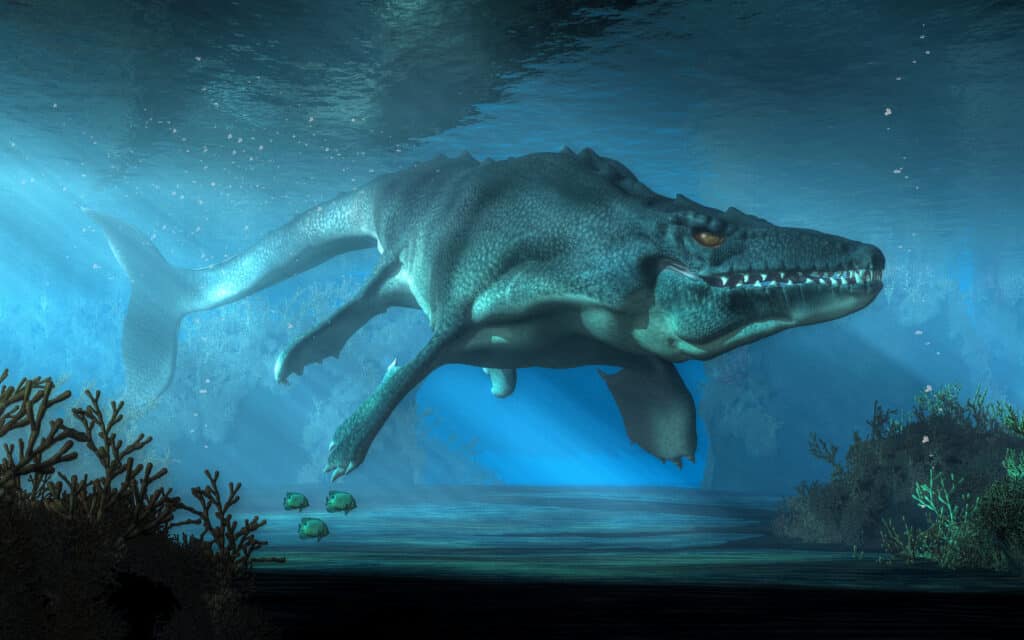
The mosasaurus was wiped out at the same time as the dinosaurs 65 million years ago in the late cretaceous era.
©Daniel Eskridge/Shutterstock.com
Mighty mosasaurus was a dangerous extinct predator with a six-foot skull that contained 250 teeth. It was a crocodilian, but paleontologists can’t decide if it’s most closely related to modern snakes or monitor lizards. Either way, this prehistoric croc was 56 feet long and weighed a massive 30,000 pounds. It had a double-hinged jaw to swallow prey whole, and a large and powerful tail for short bursts of speed. It preyed on sharks, massive fish, turtles, and birds and probably took dinosaurs from the water’s edge.
Paleontologists debate how versatile a predator mosasaurus was because its Atlantic ocean environment ranged from sub-tropical to subpolar. Many megafaunas became extinct because they couldn’t cope with climate change. However, mosasaurus lived in a wide variety of environments, so they may have been able to cope with climate change. Thankfully for their prey (and us!), mosasaurus was wiped out at the same time as the dinosaurs 65 million years ago in the late cretaceous era.
Spinosaurus
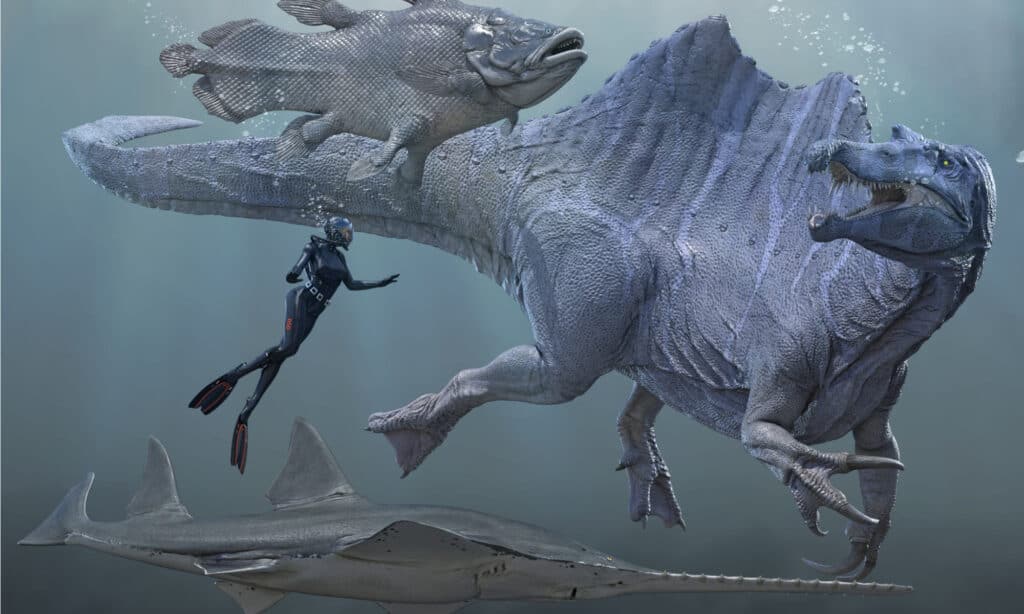
Spinosaurus could hunt on land and in water.
©Herschel Hoffmeyer/Shutterstock.com
Spinosaurus is an overlooked extinct dangerous animal. It’s on our list because it could hunt effectively on land and water. There was no escaping this predator.
Spinosaurus lived in modern-day north Africa 99 – 93 million years ago, where it was one of the longest land carnivores ever. Experts estimate it reached up to 46 feet in length and weighed 8.2 tons. Its head was crocodilian, and recent estimates put it at 5.5 feet long. Alongside its massive and powerful head, spinosaurus had three-fingered forearms that could grab and hold prey! It must have been a distinctive dinosaur with back spines that reached over five feet tall and formed a sail.
Spinosaurus had limbs strong enough to hunt down land animals but buoyant bones and a paddle-like tail to hunt in water. It lived in warm tidal flats and mangrove forests. Experts think it preyed on turtles, fish, crocodilians, and dinosaurs. Nothing was safe from this land and dangerous water-based predator.
Titanoboa

Weighing a huge 2,500 pounds, Titanoboa lived in river systems and tropical rainforests.
©Dotted Yeti/Shutterstock.com
Snake-phobes should skip this listing!
Titanoboa was a species of massive constrictor snake. There were several species, but Titanoboa cerrejoninsis was the largest. Paleontologists think it had 250 vertebrae and reached an unbelievable 42 feet in length, and that’s longer than our largest modern-day snake, the 30 feet-long green anaconda. Weighing a huge 2,500 pounds, Titanoboa lived in river systems and tropical rainforests. Experts think its fossilized teeth indicate it was pescatarian, but it was certainly capable of hunting any animal that ventured close.
Titanoboa was an apex predator of La Guajira in modern-day northeastern Columbia, but when the earth’s climate changed, its huge body couldn’t adapt in time. Dangerous Titanoboa became extinct 60 million years ago.
Pentecopterus

The pentecopterus had spines and large, grabbing limbs to trap prey.
©Patrick Lynch / CC0 1.0 – License
Pentecopterus is an extinct aquatic arthropod that lived at least 467.3 million years ago when Iowa was underwater. It belongs to an extinct group of chelicerates ‘sea scorpions’ or eurypterids, modern-day spider and horseshoe crabs’ early relatives.
Pentecopterus decorahensis is a recent addition to the fossil record. It was found in 2015 in a meteorite crater by the Upper Iowa river and named after the ancient Greek ‘pentecoster’ warships. This massive aquatic scorpion may have been one of the first early predators. Experts think it was at least five feet long, walked on the ocean floor, and maybe crawled onto land to spawn. It had spines and large, grabbing limbs to trap prey.
There’s still a lot to learn about this early dangerous animal. This article from BMC Ecology and Evolution begins to unpick what exactly this giant aquatic scorpion looked like and how it may have behaved.
Deinosuchus
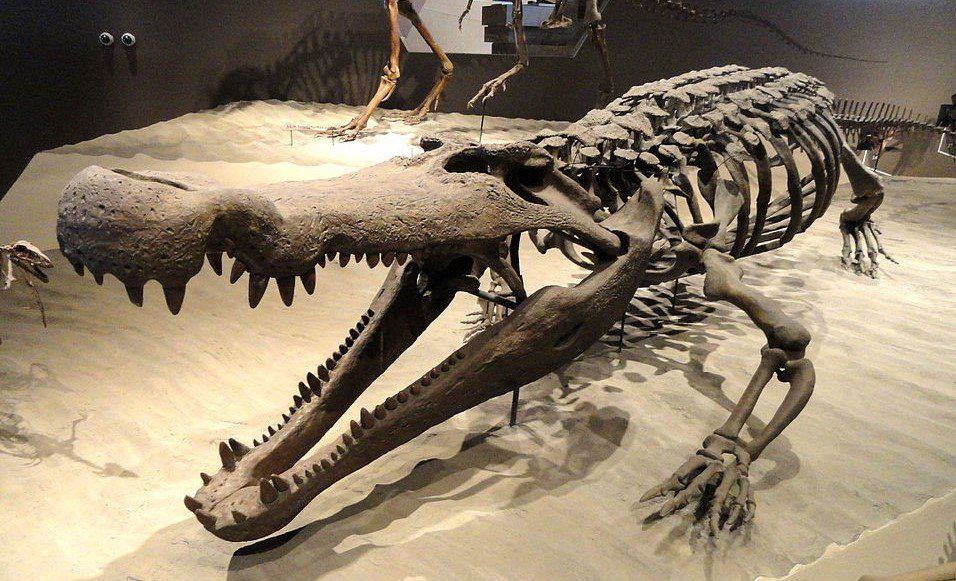
The deinosuchus was 39 feet long with a six-foot-long head and weighed between five and ten tons.
©Daderot / CC0 1.0 – License
Deinosuchus was one of many prehistoric giant crocodiles, but its pure size makes it one of the most dangerous extinct animals. This croc was 39 feet long with a six-foot-long head and weighed between five and ten tons. Its name means ‘terrible crocodile in ancient Greek, which is a good choice because experts think its bite force was 20,000 pounds. For comparison, a modern saltwater crocodile can only manage around 3,700 pounds.
Its fossilized remains are found across North America. It was a tropical area then, so deinosushcus likely preyed on massive fish, turtles, and dinosaurs drinking from the river edge. Its pointed snout with a secondary palate allowed it to remain underwater and breathe before it ambushed its prey.
This massive croc became extinct in the late Cretaceous era, 73 million years ago, before the mass extinction of the dinosaurs. Experts think deinosuchus became extinct because the climate changed and its massive size couldn’t adapt.
Short-Faced Bear
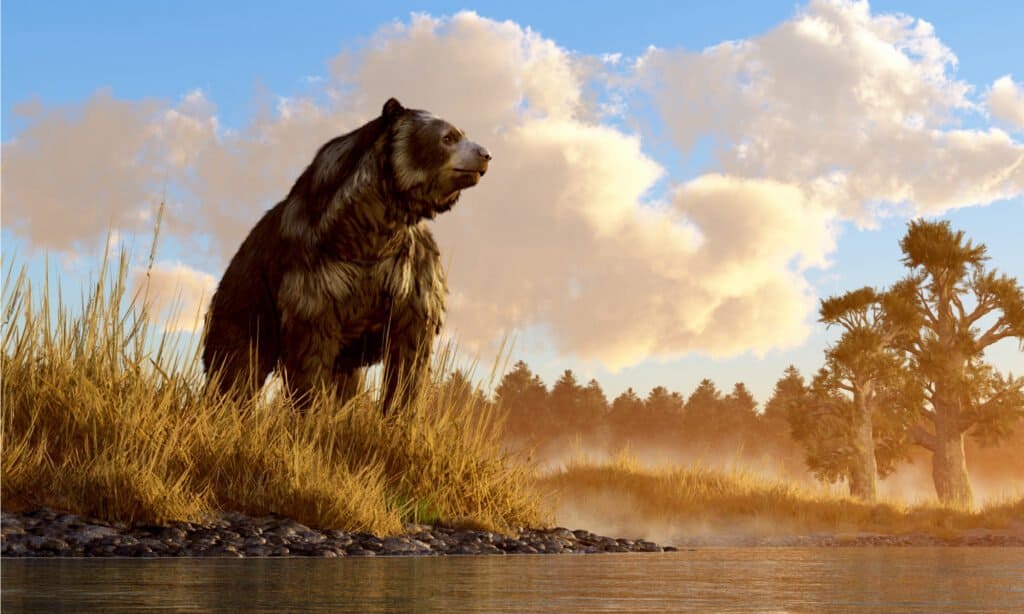
Extinct short-faced bears stood 10 feet tall on their hind legs. They hunted wild horses and giant sloths up to 11,000 years ago.
©Daniel Eskridge/Shutterstock.com
Arcdotus is a species of extinct dangerous bear that lived up to 11,000 years ago in the last ice age. This predator roamed north America preying on deer, wild horses, and even giant sloths. Experts think short-faced bears could have run at up to 40 mph to ambush their prey.
There were two species. The lesser short-faced bear and the giant short-faced bear. They got the name because their snouts were shorter than modern bears, and this shortened snout would have increased their bite force. Both species were apex predators but probably omnivores. Fossilized remains indicate they weighed up to 2,000 pounds. On all fours, a prehistoric cave bear was five feet, but on its hind legs reached ten feet tall.
Fossils found in caves indicate they hibernated in very cold months and butchery marks on bones show humans hunted them. No doubt their warm skins and meat were attractive to humans – if they were able to kill one, which would have been very hard indeed.
Cave bears became extinct 11,000 years ago due to a combination of climate change and lack of prey plus potentially human hunting.
Haast’s Eagle

The Maori people tell stories of Haast’s eagles grabbing children when their natural prey, the moa bird, was hunted to extinction.
©John Megahan / CC BY 2.5 – License
Haast’s eagle isn’t well known, but it should be! This dangerous extinct animal was a powerful 30-pound raptor endemic to South Island in New Zealand until the 1400s. The Maori people tell stories of Haast’s eagles grabbing children when their natural prey, the moa bird, was hunted to extinction.
This bird of prey was the largest eagle to have existed. Its 30-pound weight outpaces the modern-day 20-pound harpy eagle. Its wing span measured up to ten feet, which is short for its weight but more suited to hunting in dense bushland. Its 4.5-inch claws enabled it to grab and pin down flightless moa birds that were 15 times heavier.
Experts think this eagle grew to such vast proportions because the moa bird was so large. Whether or not it preyed on children isn’t confirmed, but experts think this massive eagle’s size would have made it possible.
Megapiranhas
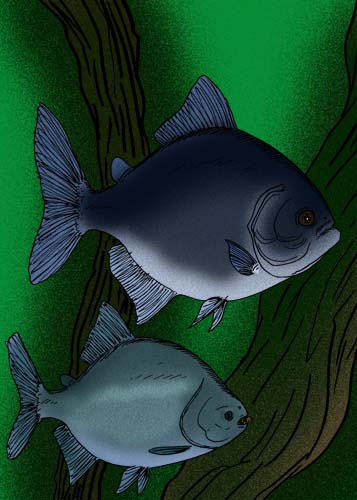
If you fell in the water during the Miocene era, megapiranhas would tear off flesh lumps with jaws having more force than megalodons.
©Apokryltaros / CC BY-SA 4.0 – License
Yes, megapiranhas existed, and although they are extinct now, they live on in nightmares!
Massive piranhas lived in modern-day south America around 10-6 million years ago in the Miocene era. Experts think they were 28 inches long and weighed around 22 pounds.
There’s not much to go on in the fossil record, but paleontologists have found fossilized triangular serrated teeth. They think this early piranha was carnivorous but also herbivorous.
If you fell in the water during the Miocene era, megapiranhas would tear off flesh lumps with jaws so powerful that pound for pound, they had more force than megalodons. This carnivorous fish preyed on anything in the water, including giant-sized snakes, crocodiles, fish, and anything unlucky enough to fall in. Alongside vegetation, of course!
That concludes our list of dangerous extinct animals. There are so many this list could go on for pages. Next time someone asks you about dangerous extinct animals, you’ll have much more to suggest than the T-rex!
Summary of 9 Dangerous Extinct Animals
| Rank | Species | Length | Weight |
|---|---|---|---|
| 1 | Megalodon | 60 feet | 227,500 pounds |
| 2 | Mosasaurus | 56 feet long | 30,000 pounds |
| 3 | Spinosaurus | 46 feet | 8.2 tons |
| 4 | Titanoboa | 42 feet | 2,500 pounds |
| 5 | Pentecopterus | 5 feet 7 inches | Unknown |
| 6 | Deinosuchus | 39 feet | 5 – 10 tons |
| 7 | Short-Faced Bear | 10 feet | 2,000 pounds |
| 8 | Haast’s Eagle | 10 feet (wingspan) | 30 pounds |
| 9 | Megapiranhas | 28 inches | 22 pounds |
The photo featured at the top of this post is © Dotted Yeti/Shutterstock.com
Thank you for reading! Have some feedback for us? Contact the AZ Animals editorial team.






